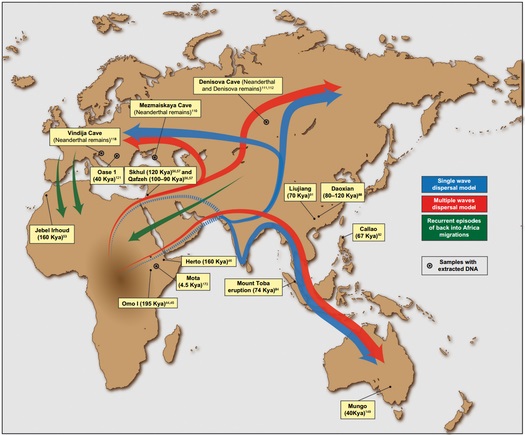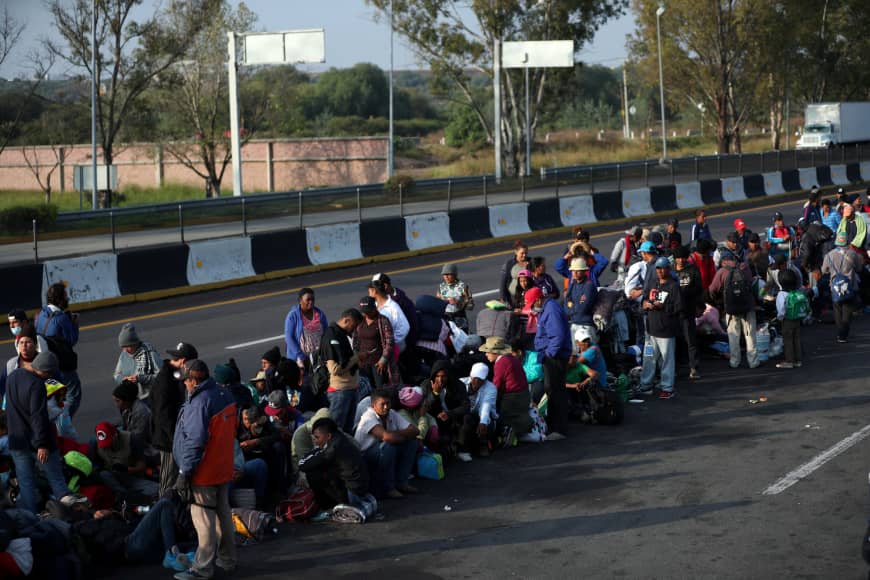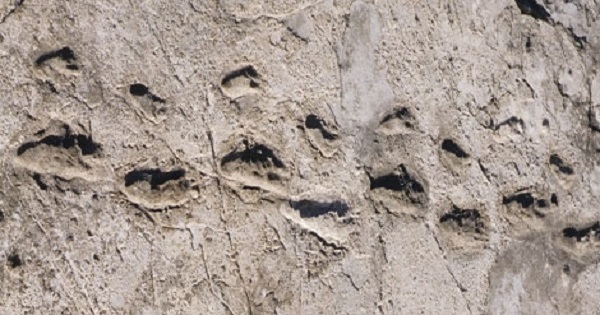
Humanity has itchy feet. Long before he flew his first powered flight, before he wheeled his first wheel, and even before he tamed his first horse, man was on the move. Within just a few thousand years of leaving Africa, he had settled the world twice over.
The evidence is piecemeal, but it looks as if the first enduring, large-scale exodus of Homo sapiens from Africa took place around 70,000 years ago (although our ancestor, Homo erectus, had ventured abroad a million years before, leaving remains as far apart as Spain and Taiwan, and Homo heidelbergensis, forefather of the Neanderthals, had already arrived in Europe). A group of more or less modern humans crossed the Bab-al-Mandab Strait on foot from present-day Yemen to Djibouti. Some headed north, some west, some east, and within 10,000 years, the descendants of these intrepid explorers had reached northern Europe, eastern Asia and Australia.
By 20,000BC, humans had crossed from the far east to the Americas via a convenient ice bridge over the Bering Strait. Within 8,000 years, they had reached modern-day Chile.
 Prehistory being pre-history, we’ll never know for sure what drove those early upheavals. Speculation has centred on climatic and ecological pressures – the ice age, desertification, loss of tree cover, changes in sea level – but since many self-evidently remained in Africa, some of the movement may simply be attributable to overspill, competition with neighbouring tribes, and the serendipity of the hunter-gatherer lifestyle: “Ooh, look! There are more goats and more fresh water in the next valley.”
Prehistory being pre-history, we’ll never know for sure what drove those early upheavals. Speculation has centred on climatic and ecological pressures – the ice age, desertification, loss of tree cover, changes in sea level – but since many self-evidently remained in Africa, some of the movement may simply be attributable to overspill, competition with neighbouring tribes, and the serendipity of the hunter-gatherer lifestyle: “Ooh, look! There are more goats and more fresh water in the next valley.”
Snap, crackle and stop
Agriculture changed everything. The domestication of pigs and cultivation of cereals about 12,000 years ago obviated the need for hunting and gathering, and made roaming harder; growing root crops means putting down roots. The improved efficiency of food production also meant that a smaller area of land could support a greater number of individuals.
So successful were these proto-farms that they quickly proliferated and expanded, soon coalescing into small communities, then towns, then cities. The next few millennia brought technological innovation and trade, which only accelerated the trend towards ever larger settled populations. And in between their many and ruinous wars, the cities gradually formed alliances, which solidified into nation states. And with nation states came borders.
(There is no mistaking the direction of travel here. Throughout history, the size of the communities in which humans could manageably live has grown, from tribes to farms to villages to towns to cities to countries to supranational entities like the European Union. And in that time – a propos of nothing – the amount of violence has fallen dramatically.)
Now humans were limited politically as well as practically in terms of where they could go. And yet the peregrinations went on; natural disasters, famines and droughts are no respecters of borders, and war continued to displace millions. Since the dawn of civilisation, to take a handful of examples, we have seen the Jewish diaspora, the spread of the Huns across central Asia and Europe, the expulsion of the Huguenots from Catholic France, the settlement of the Americas by European powers and the forcible relocation of millions of Africans as slaves.
Resettlements large scale and small continue to this day (I wouldn’t be writing this if they weren’t). The last century has seen a further surge in the US population, Nazis deporting 8 million Jews and other minorities, and the Rohingya driven from Myanmar. Some peoples, of course, never stopped gadding about; there are still plenty of nomadic tribes in Africa, Siberia and Afghanistan, and many Australian Aborigines still go on their “walkabout”.
Even in the most stable cultures, wanderlust is still very much a thing. Most people now channel it into formalised escapes such as fortnights in Europe or gap years. But that’s not enough for some. They take up itinerant lifestyles; they uproot themselves entirely and start new lives on the other side of the world; they retire to sunny Spain. Around 130,000 Britons depart these shores for good every year (it’s telling that there is a wealth of information out there on the number of immigrants entering Britain, but very little about the number of people leaving).
In the modern era, we have a much better understanding of the reasons behind these upheavals. They can be divided into two categories: voluntary and involuntary. The first group consists overwhelmingly of economic migrants (although people also emigrate for love, lifestyle, climate and curiosity). In the latter camp, we have forcible removal – slavery and trafficking – and displacement due to war, famine, overpopulation and religious persecution. Those who cross borders for any of these reasons are classified in international law as refugees (asylum seekers while their status is being confirmed).
How does the total break down? To take the recent history of the UK as an example, refugees make up less than 10% of the total of newcomers; the UK receives about 50,000 asylum applications per year – many of which are unsuccessful – out of a total of 550,000 migrants. For comparison, Turkey is currently harbouring more than 2,500,000 displaced people.
An Englishman’s home …
You might expect island nations to be a special case. When your borders are naturally defined, there’s little scope for dispute, and having a giant moat around the country hampers wantaways as much as it does invaders. This is certainly true of Iceland, which has largely been a bystander in the global hurly-burly and consequently has a population so homogeneous, they’ve developed an app to prevent accidental incest.
Things panned out rather differently in the British Isles.
While Homos antecessor and heidelbergensis apparently paid visits to Britain while it was still attached to the European mainland, and several groups of Neanderthals popped in, the land was not continuously settled until the end of the last ice age 11,000 years ago. The first modern humans to arrive were Neolithics about whom we know next to nothing. Next up were the Beaker People, probably originally from Portugal, in around 2,500BC, followed by two waves of Celts from central Europe, and the Romans. (Side note: the occupation forces were not, for the most part, Roman, being made up of tribes from all across Europe and North Africa.)
Rome’s withdrawal was the cue for another spate of incursions. First came the Germanic tribes, mostly Angles, Saxons, Jutes and Frisians. Just as they were settling in, the Vikings turned up. After a few generations of pillaging and raping raids, many of them, too, settled down. Then came William the Bastard.
And despite the nationalist boast that Britain has repulsed all invaders since 1066, the influxes didn’t end there. Many of the pilgrims who flocked to Canterbury from across Europe never left. Specialist tradesmen – weavers, cobblers, masons, miners, brewers – filed in from France, Belgium, the Netherlands and Germany. Thousands of French and Flemish Jews came at the bidding of the Norman court. Tens of thousands of Huguenots, fleeing persecution in 17th-century Catholic France, chose England as their haven. They were followed by waves of Dutchmen, Travellers, Italians, and Irish. Almost all received the sort of reception that would make a Daily Mail editor proud.
And yet without these injections of labour, talent and energy, there would have been no British Empire. It was the Huguenots who brought the textile expertise that gave the country a solid financial base. Britain’s navy would have been far less formidable without the technical prowess of Dutch engineers. And the subjugation of India and the slave trade (all the advantages of immigration, but none of the bother of letting them in!) swelled British coffers to the point where it could begin to paint two-thirds of the globe pink.
For all the nationalists’ claims of “British purity”, if you were to take a DNA test, there’s every chance that as well as Angle, Saxon and Norman blood, there’d be traces of Beaker people, Celts, Picts, Gauls, Mediterraneans, north Africans, various Danes, French Huguenots, Flemish, Germans, Dutch, Ashkenazy Jews, Italians, Gypsies and Irish.

To boldly go
Humanity has only been relatively sedentary for a tiny portion of its history. It would be preposterous if we had shed all our wayfaring instincts in the space of a few generations.
Sure, we have a sense of home, of identity, of belonging; but we also have a driving need to move on, to explore, to seek out new worlds and civilisations. Humanity’s passion for discovery has already driven us to every corner of the globe, to the darkest depths of the ocean and the largest object in the night sky – and still we yearn to go further.
Migration is in our marrow. To jam a spoke in the wheel at an arbitrary point in history – to say, “It ends here” when the world is changing at ever more bewildering speed – is not just economic and political folly; it’s a denial of our very nature.

